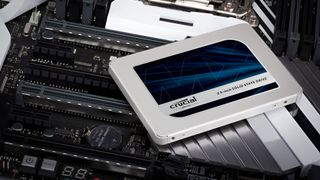For a long time, PC gamers fitting an SSD to their rig would have used a 2.5-inch drive with a SATA interface. The best one to get was a Crucial MX500 and it was so good that it topped the charts for almost seven years. However, all good things must eventually end, and parent company Micron has begun calling time on the evergreen SSD.
News of the MX500 being discontinued was confirmed by ComputerBase (which caught wind of the decision via a Reddit user) and while it shouldn't come as a surprise, given the sheer popularity of NVMe M.2 SSDs, I'm a little sad to see it go.
One reason for this is that an awful lot of motherboards only have two or three M.2 sockets, so if you need more storage once they're all in use you either have to use a PCIe expansion card or, more sensibly, the SATA ports on the board.
Cheap SATA SSDs all use QLC NAND memory chips and they usually don't sport DRAM, either, so their performance isn't exactly stellar. Not so the Crucial MX500, as it sports faster TLC chips and a reasonable chunk of DRAM, and it consistently outperformed the competition (except Samsung's considerably more expensive 850 Pro).
Of course, the SATA interface doesn't have anywhere near the same levels of bandwidth and timings as PCI Express, which is why NVMe SSD rule the roost these days. Take the best gaming M.2 SSD, the WD Black SN850X, for example—you're looking at up to 7,300 and 6,300 MB/s sequential read/write performance, whereas the MX500 tops out at 550 and 510 MB/s respectively.
That's actually enough for most games, as very few of them absolutely hammer storage drives for assets once they're up and running. During loading, it's a different story, but once everything has settled down, a SATA SSD is fine to use for gaming.
It's worth noting that not every variant of the MX500 has reached EOL (end-of-life) status yet—a quick scan of Crucial's site shows that it's pulled the plug on the 250 GB and 4 TB models, while 500 GB, 1 and 2 TB models are still available.
However, I should imagine that these won't be around for much longer as Micron has told ComputerBase that it is "making room in the line for new products."
My guess is that it will bring much larger capacities to the market at a more affordable price than they currently are. Well, that's my hope, at least. It's also worth noting that if you've recently bought a 4 TB MX500 and you make a warranty claim for a new one, Crucial won't be able to replace it like-for-like.
The 4 TB version of the MX500 wasn't as good as the 1 and 2 TB models, so if you're looking to slap a big cheap SSD into your rig, you might want to wait and see what Crucial replaces the MX500 with. With CES 2025 just around the corner, I should imagine we'll get word of the new line at that event.
Until then, I'm going to root around in some boxes and find my old 500 GB MX500s. They stopped working years ago (they had a tough life, so it wasn't a remark about their frailty) but I just want to hold one again for nostalgia.

 2 weeks ago
7
2 weeks ago
7








:quality(85):upscale()/2024/06/27/002/n/43463692/273a0466667defdb06a697.27831546_.jpg)
 English (US) ·
English (US) ·